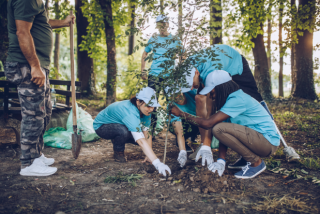Community Member Tree Planting Efforts
As you or your neighbors seek to increase vegetation and reduce heat islands in your community, keep in mind the following considerations.
Tree Planting Considerations

Vegetation selection. Vegetation must be right for the local climate. For example, a desert environment needs species that can withstand hot and dry weather. Additionally, vegetation must be placed in the right location on the site. For example, researchers have found that planting deciduous trees or vines to the west is most effective for cooling a building, especially if they shade the windows and roof.
Vegetation maintenance. After initial planting, trees require regular maintenance to survive. These maintenance requirements generally decline over time. You can lessen maintenance costs by planting native species, and avoiding planting near utilities, sidewalks, and other infrastructure.
Legal issues. Trees and vegetation may cause legal or insurance issues when they violate local policies, encroach on another property, block views, or cause damage. Such issues can be avoided by consulting local government guidelines on planting or approved species, checking with homeowners associations and neighbors before planting, properly maintaining vegetation, and maintaining insurance coverage.
Safety. Trees are linked to both increased and decreased safety. Consider if trees may increase unsafe conditions, such as fire hazards in wildfire-prone areas and older, taller trees in close proximity to schools. Contrary to popular belief, trees can make our neighborhoods safer. A multi-country study found that a one percent increase in green space per person was linked to a one-tenth of one percent decrease in crime.1 Careful selection and maintenance of trees can reduce these unsafe conditions while keeping our communities green.
More Information and Resources
More details are available in Chapter Two of EPA’s Reducing Urban Heat Islands: Compendium of Strategies, which covers the following topics:
- How trees and vegetation reduce temperatures
- The benefits and costs associated with trees and vegetation
- Other factors to consider when using trees and vegetation
- Urban forestry initiatives
- Tree and vegetation tools and resources
Resources for Community Members
References
1. Demir, C. and S.E. Ozcan. 2023. Do air quality and green space reduce propensity to crime?: An empirical investigation of OECD countries. Management of Environmental Quality 34(2): 351-367.
